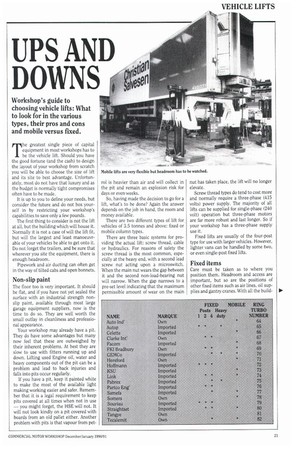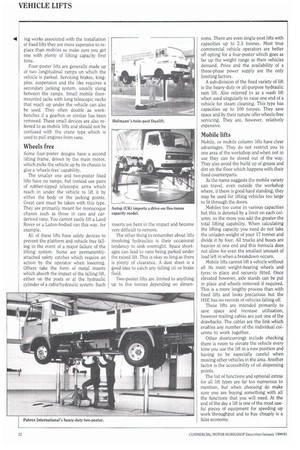UPS AND DOWNS
Page 97

Page 98

If you've noticed an error in this article please click here to report it so we can fix it.
Workshop's guide to
choosing vehicle lifts: What to look for in the various types, their pros and cons and mobile versus fixed.
The greatest single piece of capital equipment in most workshops has to be the vehicle lift. Should you have the good fortune (and the cash) to design the layout of your workshop from scratch you will be able to choose the size of lift and its site to best advantage. Unfortunately, most do not have that luxury and as the budget is normally tight compromises often have to be made.
It is up to you to define your needs, but consider the future and do not box yourself in by restricting your workshop's capabilities to save only a few pounds.
The first thing to consider is not the lift at all, but the building which will house it. Normally it is not a case of will the lift fit, but will the largest and least manoeuvrable of your vehicles be able to get onto it. Do not forget the trailers, and be sure that wherever you site the equipment, there is enough headroom.
Pipework and air ducting can often get in the way of tilted cabs and open bonnets.
Non-slip paint
The floor too is very important. It should be flat, and if you have not yet sealed the surface with an industrial strength nonslip paint, available through most large garage equipment suppliers, now is the time to do so. They are well worth the small outlay in cleanliness and professional appearance.
Your workshop may already have a pit. They do have some advantages but many now feel that these are outweighed by their inherent problems. At best they are slow to use with fitters running up and down. Lifting used Engine oil, water and heavy components out of the pit can be a problem and lead to back injuries and falls into pits occur regularly.
If you have a pit, keep it painted white to make the most of the available light making working easier and safer. Remember that it is a legal requirement to keep pits covered at all times when not in use — you might forget, the HSE will not. It will not look kindly on a pit covered with boards from an old pallet either. Another problem with pits is that vapour from pet
rol is heavier than air and will collect in the pit and remain an explosion risk for days or even weeks.
So, having made the decision to go for a lift, what's to be done? Again the answer depends on the job in hand, the room and money available.
There are two different types of lift for. vehicles of 3.5 tonnes and above: fixed or mobile column types.
There are three basic systems for providing the actual lift: screw thread, cable or hydraulics. For reasons of safety the screw thread is the most common, especially at the heavy end, with a second lead screw nut acting upon a microswitch. When the main nut wears the gap between it and the second non-load-bearing nut will narrow. When the gap narrows to a pre-set level indicating that the maximum permissible amount of wear on the main nut has taken place, the lift will no longer elevate.
Screw thread types do tend to cost more and normally require a three-phase (415 volts) power supply. The majority of all lifts can be supplied for single-phase (240 volt) operation but three-phase motors are far more robust and last longer. So if your workshop has a three-phase supply use it.
Fixed lifts are usually of the four-post type for use with larger vehicles. However, lighter vans can be handled by some two, or even single-post fixed lifts.
Fixed items
Care must be taken as to where you position them. Headroom and access are important, but so are the positions of other fixed items such as air lines, oil supplies and gantry cranes. With all the build ing works associated with the installation of fixed lifts they are more expensive to replace than mobiles so make sure you get one with plenty of lifting capacity first time.
Four-poster lifts are generally made up of two longitudinal ramps on which the vehicle is parked. Servicing brakes, kingpins, suspension and the like requires a secondary jacking system, usually slung between the ramps. Small mobile floormounted jacks with long telescopic necks that reach up under the vehicle can also be used. They often double as workbenches if a gearbox or similar has been removed. These small devices are also referred to as mobile lifts and should not be confused with the crane type which is used to pull engines from vans.
Wheels free
Some four-poster designs have a second lifting frame, driven by the main motor, which picks the vehicle up by its chassis to give a 'wheels-free' capability.
The smaller one and two-poster fixed lifts have no ramps, but instead use pairs of rubber-tipped telescopic arms which reach in under the vehicle to lift it by either the body or the jacking points. Great care must be taken with this type. They are primarily meant for monocoque chassis such as those in cars and carderived vans. You cannot easily lift a Land Rover or a Luton-bodied van this way, for example.
All of these lifts have safety devices to prevent the platform and vehicle free falling in the event of a major failure of the lifting system. Some are permanentlyattached safety catches which require an action by the operator when lowering. Others take the form of metal inserts which absorb the impact of the falling lift, either on the posts or at the hydraulic cylinder of a cable/hydraulic system. Such inserts are bent in the impact and become very difficult to remove.
The other thing to remember about lifts involving hydraulics is their occasional tendency to sink overnight. Space shortages can lead to vans being parked under the raised lift. This is okay so long as there is plenty of clearance. A dust sheet is a good idea to catch any falling oil or brake fluid.
Two-poster lifts are limited to anything up to five tonnes depending on dimen sions. There are even single-post lifts with capacities up to 2.5 tonnes. Most true commercial vehicle operators are better off opting for a four-poster which goes as far up the weight range as their vehicles demand. Price and the availability of a three-phase power supply are the only limiting factors.
A sub-division of the fixed variety of lift is the heavy-duty or all-purpose hydraulic ram lift. Also referred to as a wash lift when used singularly to raise one end of a vehicle for steam cleaning. This type has capacities up to 100 tonnes. They save space and by their nature offer wheels-free servicing. They are, however, relatively expensive.
Mobile lifts
Mobile, or mobile column lifts have clear advantages. They do not restrict you to one area of the workshop and when not in use they can be stored out of the way. They also avoid the build up of grease and dirt on the floor which happens with their fixed counterparts.
As the name suggests the mobile variety can travel, even outside the workshop where, if there is good hard standing, they may be used for lifting vehicles too large to fit through the doors.
Mobiles too come in various capacities but this is denoted by a limit on each column, so the more you add the greater the total lifting capability. When calculating the lifting capacity you need do not take the unladen weight of your 17 tonner and divide it by four. All trucks and buses are heavier at one end and this formula does not allow for even the smallest amount of load left in when a breakdown occurs.
Mobile lifts cannot lift a vehicle without all its main weight-bearing wheels and tyres in place and securely fitted. Once elevated however, axle stands can be put in place and wheels removed if required. This is a more lengthy process than with fixed lifts and looks precarious but the USE has no records of vehicles falling off.
These lifts are intended primarily to save space and increase utilisation, however trailing cables are just one of the drawbacks. The cables are the link which enables any number of the individual columns to work together.
Other shortcomings include checking there is room to elevate the vehicle every time you use the lift in a new position and having to be especially careful when moving other vehicles in the area. Another factor is the accessibility of oil dispensing points.
The list of functions and optional extras for all lift types are far too numerous to mention, but when choosing do make sure you are buying something with all the functions that you will need. At the end of the day a lift is one of the most useful pieces of equipment for speeding up work throughput and to buy cheaply is a false economy.












































































































